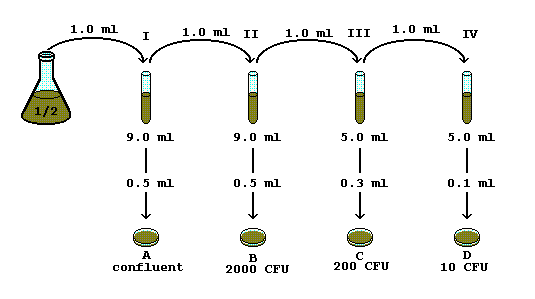Serial Dilution Problem Help
Serial dilutions are used to calculate the concentration of microorganisms.
As it would usually be impossible to actually count the number of microorganisms
in a sample, the sample is diluted and plated to get a reasonable number of
colonies to count. Since each colony on an agar plate theoretically grew from a
single microorganism, the number of colonies or Colony Forming Units is
representative of the number of viable microorganisms. Since the dilution
factor is known, the number of microorganisms per ml in the original sample can
be calculated.

A dilution problem such as the one shown above is relatively easy to solve
if taken step by step. Follow the steps below.
- First determine which is the countable plate.
- Count the number of colonies on each plate. If there are too many colonies
on the plate, the colonies can run together and become indistinguishable as
individual colonies. In this case the plate is called confluent or Too Numerous
To Count (TNTC). The countable plate has between 30 and 300 colonies. More
than 300 colonies would be difficult to count, and less than 30 colonies is too
small a sample size to present an accurate representation of the original
sample. As stated above, the number of colonies is the number of Colony Forming
Units which represents the number of microorganisms per ml.
- Sample Dilution Factor (SDF)
- A sample is often diluted prior to doing the serial dilutions. If it is,
the sample dilution factor will be shown in the diagram as above (the 1/2 in the
erlenmeyer flask is the sample dilution factor). If the sample remains
undiluted, use 1/1 as the Sample Dilution Factor.
- Individual Tube Dilution Factor (ITDF)
- The individual tube dilution factors are a calculation of how much the
sample was diluted in each individual tube. This is just the amount of sample
added to the tube divided by the total volume in the tube after adding the
sample. In tube I above, 1 ml of sample was added to 9 ml of water, so the ITDF
for tube I is: 1ml/1ml + 9 ml = 1/10
- Total Series Dilution Factor (TSDF)
- The total series dilution factor is a calculation of how much the sample
was diluted in all of the tubes combined. This is accomplished by multiplying
each of the appropriate ISDF. This series does not include any dilutions after
the countable plate. In the example above, since the countable plate was plate
C, tube IV is not included in the TSDF. The TSDF for the example above is 1/10
(ITDF for tube I) x 1/10 (ITDF for tube II) x 1/6 (ITDF for tube III) = 1/600.
- Plating Dilution Factor (PDF)
- When the sample is plated, a dilution factor must also be calculated for
this transfer. Since the object of these calculations is to determine CFU/ml,
the amount plated for the countable plate is divided by 1 ml to get the PDF. In
the example above, 0.3 ml from tube III was plated onto plate C, so the PDF is
0.3ml/1.0 ml = 0.3ml/1.0ml x 10/10 = 3/10.
- Final Dilution Factor (FDF)
- The FDF takes into account all of the above dilution factors, giving you
the total dilution from the original sample to the countable plate. The FDF =
SDF x TSDF x PDF, so in this example, the FDF = 1/2 x 1/600 x 3/10 = 3/12000 =
1/4000. This means that the original sample was 4000 times as concentrated as
the plated sample from tube III. In other words, it would take 4 L of the
sample in tube III to contain the same number of bacteria as 1 ml of the
original sample.
- Colony Forming Units/ml (CFU/ml) in original sample
- To find out the number of CFU/ ml in the original sample, the number of
colony forming units on the countable plate is multiplied by 1/FDF. This takes
into account all of the dilution of the original sample. For the example above,
the countable plate had 200 colonies, so there were 200 CFU, and the FDF was
1/4000.
- 200 CFU x 1/1/4000 = 200 CFU x 4000 = 800000 CFU/ml = 8 x 10

- CFU/ml in the original sample.
Note: Thanks are given to Tim Allen for creating this help unit.
First Problem




©The University of Vermont




